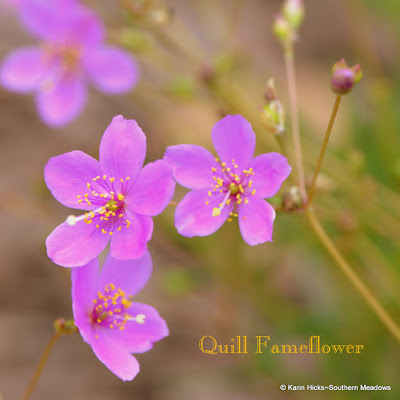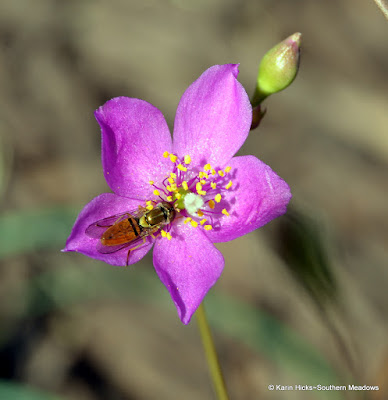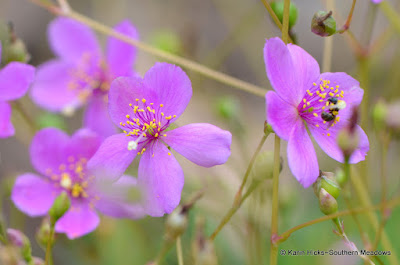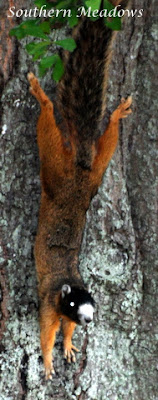Wildflower Wednesday: Quill Fameflower
May blooms are plentiful in our garden so trying to choose which plant to feature for Wildflower Wednesday, hosted by Clay and Limestone, wasn't easy. I contemplated several noteworthy candidates but ultimately picked this sweet succulent, the quill fameflower (Phemeranthus teretifolium/Talinum teretifolium).
It grows naturally around granite outcrops in a few southeastern states. Although it is found in restricted habitats, this member of the Portulacaceae family is widespread in the areas where it is found.
The fuchsia hued flowers bloom from early summer into late fall. The ephemeral blooms, which only open for a few hours on sunny afternoons, provide a significant nectar source for a variety of native bees and other small pollinators. But you'll have to get close at plant level to observe the tiniest of pollinators. As the flower is only open for a brief time, it can self pollinate if it isn't serviced.
The fleshy foliage is designed to store water and taller stems hold the dainty blooms that reach for the sun.
I found this Quill fameflower last year at Georgia Perimeter College Botanical Garden and was able to incorporate it into our landscape plan. Their plant sale space has fabulous demonstration gardens that educate visitors about the native plants they sell. In addition to selling plants, they offer talks and walks through the grounds by knowledgeable speakers. If you are in the area, I highly recommend you stop and shop.
Taking a cue from where this tiny succulent grows naturally, it is wonderfully suited for a rock garden, gravel barren, stony ledges or a living roof. We incorporated this drought tolerant plant into our hillside along the front steps (read more here), where it is exposed to full day sun and well drained soil. If you live in its native range and have the right growing conditions, it is an excellent perennial succulent to incorporate into a home landscape.
It grows naturally around granite outcrops in a few southeastern states. Although it is found in restricted habitats, this member of the Portulacaceae family is widespread in the areas where it is found.
The fuchsia hued flowers bloom from early summer into late fall. The ephemeral blooms, which only open for a few hours on sunny afternoons, provide a significant nectar source for a variety of native bees and other small pollinators. But you'll have to get close at plant level to observe the tiniest of pollinators. As the flower is only open for a brief time, it can self pollinate if it isn't serviced.
The fleshy foliage is designed to store water and taller stems hold the dainty blooms that reach for the sun.
I found this Quill fameflower last year at Georgia Perimeter College Botanical Garden and was able to incorporate it into our landscape plan. Their plant sale space has fabulous demonstration gardens that educate visitors about the native plants they sell. In addition to selling plants, they offer talks and walks through the grounds by knowledgeable speakers. If you are in the area, I highly recommend you stop and shop.
Taking a cue from where this tiny succulent grows naturally, it is wonderfully suited for a rock garden, gravel barren, stony ledges or a living roof. We incorporated this drought tolerant plant into our hillside along the front steps (read more here), where it is exposed to full day sun and well drained soil. If you live in its native range and have the right growing conditions, it is an excellent perennial succulent to incorporate into a home landscape.






